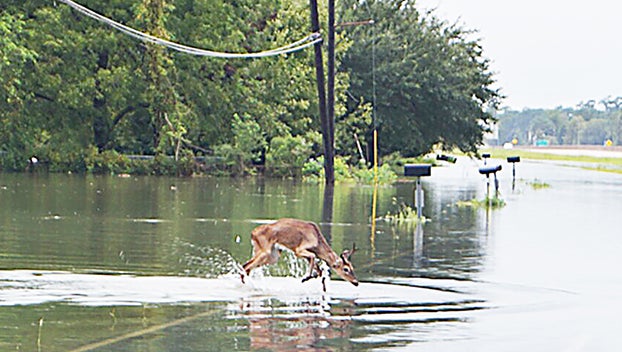HURRICANES, STORMS CHANGE DEVELOPMENT — Drainage district requires plans to withstand 100-year flood
Published 12:30 am Thursday, August 17, 2023

- A deer braves rising flood water in 2019 off Interstate 10 feeder road just west of Farm to Market Road 1442 in the aftermath of Tropical Storm Imelda. (Randy Strong/Special to The Leader)
|
Getting your Trinity Audio player ready...
|
The Orange County Drainage District has one main goal — control flood drainage for Orange County.
The 380-square mile “peninsula” has the Neches River to its west, the Sabine River to the east and Sabine Lake to the south.
The never ending flow from those bodies of water require constant maintenance and improvements to its 600-plus miles of natural and man-made ditches and channels, even more so in recent years because of nature, said Douglas E. Manning, assistant general manager.
“The vast majority of Orange County residents want and expect that county public entities, such as the Orange County Drainage District, will have policies and rules that restrict new developments from causing existing drainage to be impaired or worsened,” Manning said.
“Even before Hurricane Harvey, the Orange County Drainage District began to impose additional drainage requirements on new residential subdivision developments.
“However, after Hurricane Harvey and Tropical Storm Imelda, the district adopted a comprehensive Drainage Criteria Manual regulating all new developments.”
Manning said the district has adopted a “zero impact” policy with respect to new developments.
“Generally, this means that new development will not be allowed to increase the stormwater runoff from the developed property in a storm event with a statistical recurrence interval of 100 years or less or has a 1 percent or less chance of being exceeded in any given year,” he said.
“In other words, a new development will not be approved by the district unless the developer first demonstrates through an engineered drainage plan that the stormwater runoff from the development will not be increased at all during a “100-year” rain event.”
For example, because Orange County is relatively flat, design and construction of detention ponds are almost always required in order to meet district criteria, he said.
While the district has changed policies to respond to new flood data, changes were also made as part of a balancing act in response to “the massive economic growth and the accompanying demand for housing, commercial and industrial developments,” Manning said.
The formal process begins when a developer submits a request for a pre-
development meeting, in which the developer’s team presents an overview of
the development and receives a briefing as to what will be expected by the District
to have the drainage plan approved.
Once the developer has paid the required review fee, the developer is required to submit a drainage plan to the district’s development team.
The time between the initial pre-development meeting and the developer’s submission of a drainage plan varies significantly, Manning said.
Manning said that throughout the review process the district consults with the relevant city or county officials depending on where a development is located.
Once approved, the developer is authorized to proceed with the construction of the drainage improvements in accordance with the approved drainage plan.
“For the development of residential subdivisions, in addition to an approved drainage plan, the district requires that a homeowners’ association (“HOA”) be created to have the authorization and obligation to maintain the detention facilities,” Manning said.
“Additionally, several other dedicatory and HOA-related documents must be prepared and submitted to the district’s attorney and staff before being filed or executed.”
The district will remain involved in the construction of the development following approval of a drainage plan, said approval taking as quickly as a few days, weeks, months or even up to a year or more, he said.
— Written by Dan Bledsoe





